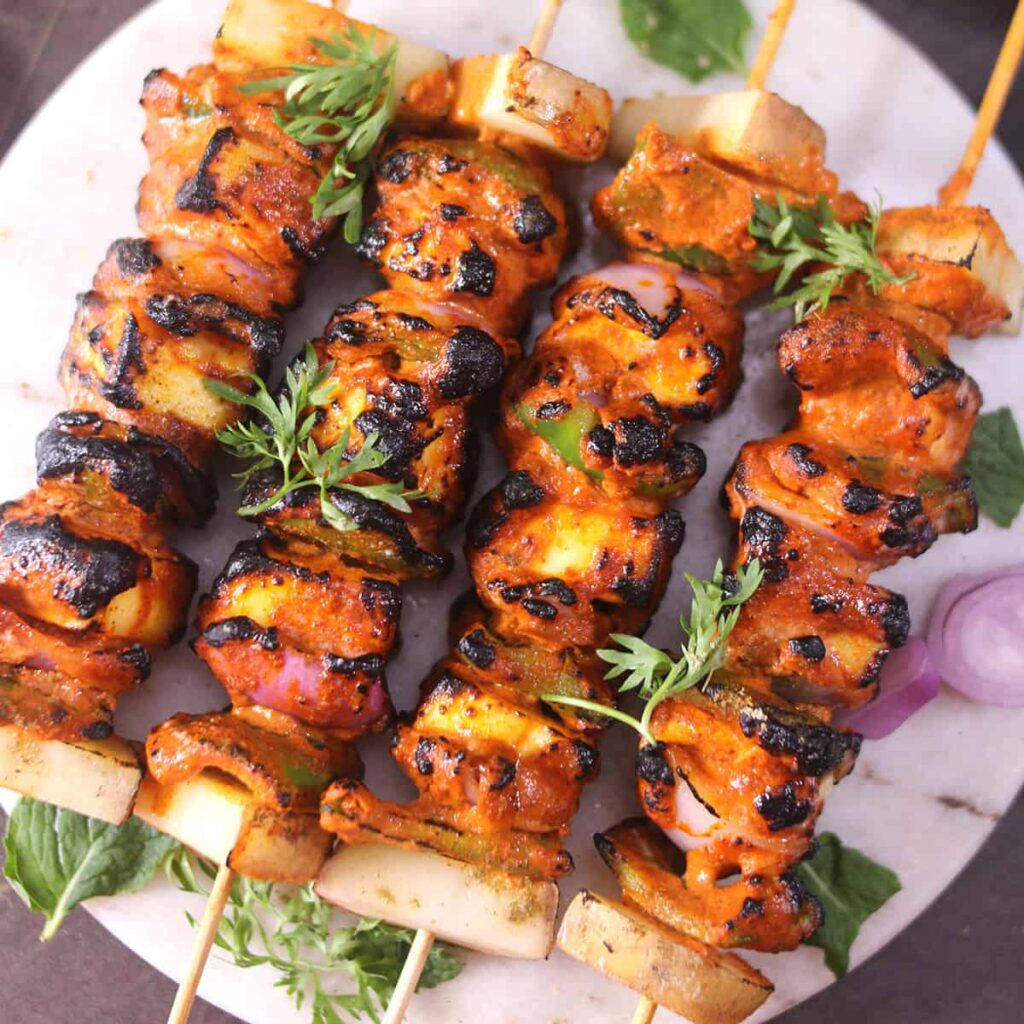Paneer Tikka: A Flavorful Journey Through India’s Culinary Heritage

Introduction: In the vibrant tapestry of Indian cuisine, there exists a dish that showcases the versatility of paneer (Indian cottage cheese) and the artistry of tandoori cooking – Paneer Tikka. This iconic appetizer, with its tantalizing aroma, vibrant colors, and bold flavors, has captured the hearts and taste buds of food enthusiasts around the world. Join us as we embark on a culinary odyssey, exploring the origins, cultural significance, and intricate recipe of Paneer Tikka, a symbol of culinary innovation and tradition.
Origins and Cultural Significance: Paneer Tikka finds its roots in the rich culinary heritage of Punjab, a region renowned for its hearty cuisine and vibrant flavors. The dish is believed to have originated as a vegetarian alternative to the popular Tandoori Chicken, offering a tantalizing blend of spices and smoky flavors without the meat.
The name “Paneer Tikka” derives from two distinct elements – “paneer,” referring to Indian cottage cheese, and “tikka,” which translates to a small, bite-sized piece of food. Traditionally, Paneer Tikka is prepared by marinating cubes of paneer in a flavorful yogurt-based marinade, skewering them, and cooking them in a tandoor (clay oven) until charred and smoky.
Paneer Tikka holds cultural significance beyond its culinary appeal, often served during festive occasions, celebrations, and family gatherings. Its vibrant colors and aromatic spices evoke a sense of joy and togetherness, symbolizing the warmth and hospitality of Indian culture.
Recipe and Preparation: The preparation of Paneer Tikka is a labor of love, requiring patience, precision, and a harmonious blend of spices and ingredients. While there are countless variations of the recipe, each chef adding their unique touch, we present a traditional Paneer Tikka recipe that captures the essence of this beloved dish.
Ingredients: For the Marinade:
- Paneer: 500 grams, cut into cubes
- Yogurt: 1 cup, hung or Greek yogurt
- Ginger-garlic paste: 2 tablespoons
- Kashmiri red chili powder: 2 teaspoons
- Turmeric powder: 1/2 teaspoon
- Garam masala powder: 1 teaspoon
- Coriander powder: 1 tablespoon
- Cumin powder: 1 teaspoon
- Chaat masala: 1 teaspoon
- Lemon juice: 2 tablespoons
- Salt: to taste
- Cooking oil: 2 tablespoons
- Fresh coriander leaves: for garnish
For Cooking:
- Skewers: wooden or metal, soaked in water (if using wooden)
- Cooking oil or ghee: for brushing
- Onion slices and lemon wedges: for serving
- Mint chutney and tamarind chutney: for serving (optional)
Instructions:
- In a large mixing bowl, combine yogurt, ginger-garlic paste, Kashmiri red chili powder, turmeric powder, garam masala powder, coriander powder, cumin powder, chaat masala, lemon juice, salt, and cooking oil to make the marinade.
- Add paneer cubes to the marinade and gently toss to coat them evenly. Cover and refrigerate for at least 1 hour to allow the flavors to meld.
- Preheat the grill or oven to medium-high heat.
- Thread the marinated paneer cubes onto skewers, leaving a small gap between each piece.
- Brush the grill grates or baking tray with oil to prevent sticking. Place the skewers on the grill or baking tray.
- Grill or bake the Paneer Tikka for 10-12 minutes, turning occasionally, until the paneer is lightly charred and cooked through.
- Once cooked, remove the Paneer Tikka from the grill or oven and transfer to a serving platter.
- Garnish with fresh coriander leaves and serve hot with onion slices, lemon wedges, and mint chutney or tamarind chutney on the side.
Conclusion: In conclusion, Paneer Tikka stands as a shining example of culinary ingenuity and cultural richness in Indian cuisine. From its humble origins in Punjab to its global popularity as a vegetarian delight, Paneer Tikka continues to captivate food enthusiasts with its bold flavors and irresistible charm. Whether enjoyed as an appetizer, snack, or party dish, Paneer Tikka embodies the spirit of celebration, togetherness, and culinary excellence. So, the next time you savor a succulent piece of Paneer Tikka, relish not just the flavors but also the centuries of tradition and innovation that have shaped its legacy.




